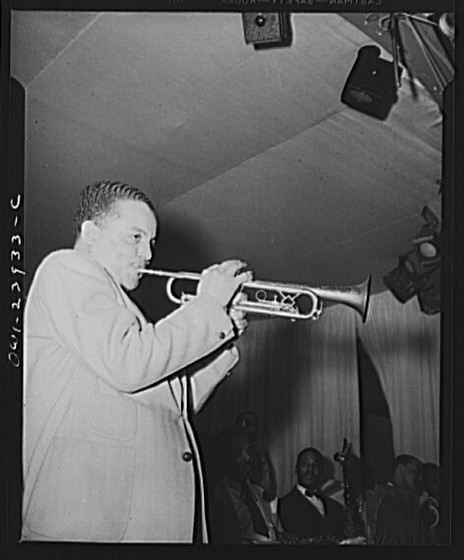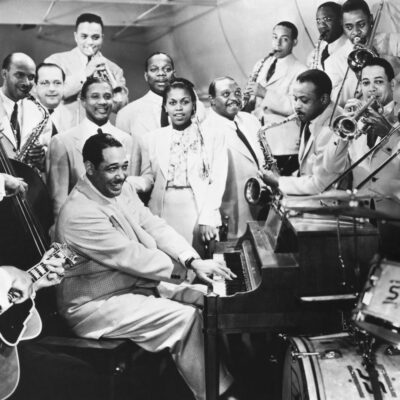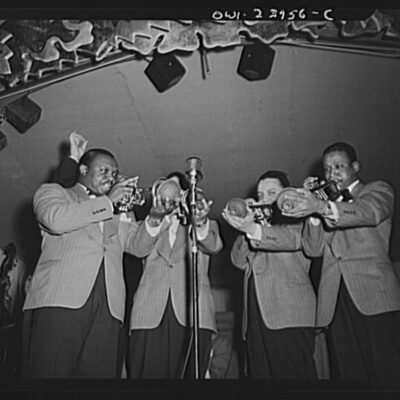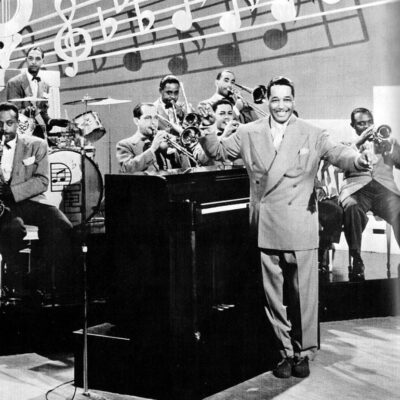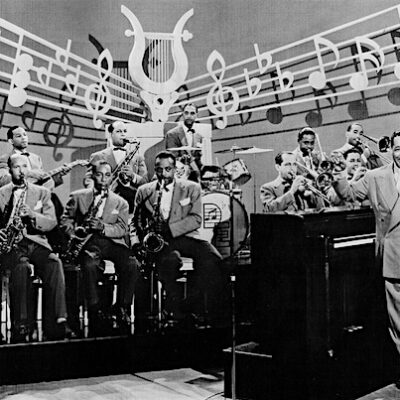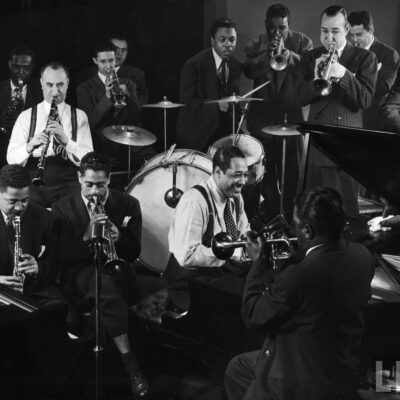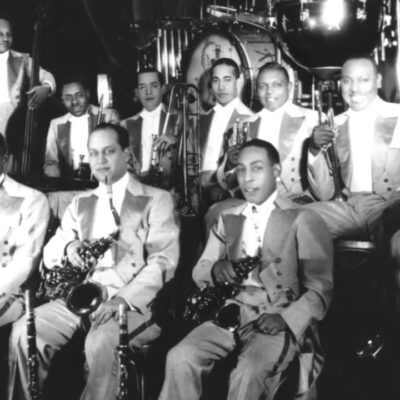THE DUKE ELLINGTON ORCHESTRA
The Duke Ellington Orchestra
Duke Ellington was eulogized as “the supreme jazz talent of the past fifty years” by critic Alistair Cooke in a 1983 issue of Esquire. A prolific composer, Ellington created over two thousand pieces of music, including the standard songs “Take the A-Train” and “It Don’t Mean a Thing (If It Ain’t Got That Swing)” and the longer works Black, Brown, and Beige, Liberian Suite, and Afro-Eurasian Eclipse. With the variously named bands he led from 1919 until his death in 1974, Ellington was responsible for many innovations in the jazz field, such as “jungle-style” use of the growl and plunger, and the manipulation of the human voice as an instrument–singing notes without words. During the course of his long career, Ellington was showered with many honors, including the highest civilian award granted by the United States, the Presidential Medal of Freedom, which was presented to him by President Richard M. Nixon in 1969. “No one else,” concluded Cooke, “in the eighty- or ninety-year history of jazz, created so personal an orchestral sound and so continuously expanded the jazz idiom.”
Born Edward Kennedy Ellington in Washington, D.C., on April 29, 1899, to a middle-class black family, he was exposed to music at an early age. Both his father–who made blueprints for the navy and served as a White House butler–and his mother could play the piano. The Ellingtonswere strongly religious and hoped that if their son learned piano he would later exchange it for the church organ, but at first he was uncooperative. At the age of six young Ellington labeled his piano teacher “Miss Clinkscales” and, according to Esquire, “was her poorest pupil,” the only child to forget his part in her yearly piano recital. As he grew older Ellington became interested in drawing and painting, and won a prize from the National Association for the Advancement of Colored People (NAACP) for a poster he created, but continued his music lessons because he noticed that pretty girls tended to flock around piano players.
Ellington began to take the piano more seriously as a high-school student and learned much from his school’s music teacher, Henry Grant. When he was fifteen Ellington worked after school in a soda shop; the experience led him to write his first jazz song, “Soda Fountain Rag.” At about this time, he also acquired the nickname Duke. There are many stories explaining how Ellington obtained the moniker, but the most prevalent says that he had a young, elegant, social-climbing friend who felt that admission into his circle demanded that Ellington have a noble title, and the label stuck. Ellington dropped out of high school to pursue his musical career, playing in jazz bands by night and supplementing his income by painting signs during the day. Often he managed to persuade club owners to let him paint the signs announcing the group’s engagement.
Influenced by the style of earlier jazz artist Doc Perry, Ellington continued to work on his piano playing and, after the end of World War I, formed his own band. Critics note that it was his band, rather than his piano, that was his true instrument. He composed, not so much with a particular instrument in mind, but rather thinking of the current band member who played that instrument, suiting the music to the style of the player. Though the turnover rate in Ellington’s band was not high, due to the band’s longevity many musicians and singers played with Ellington over the years: Toby Hardwick, Elmer Snowden, William Greer, Barney Bigard, Wellman Braud, Harry Carney, Johnny Hodges, Bubber Miley, Joe Nanton, Cootie Williams, Adelaide Hall, and Billy Strayhorn are among the more notable. Ellington and his band began playing local clubs and parties in Washington, D.C., during the early 1920s, but soon moved to New York City, where they secured a three-year engagement at the popular Cotton Club.During the 1920s and 1930s, Ellington branched out into writing musical revues, such as Chocolate Kiddies, a success in Germany; playing in Broadway musicals, such as the 1929 Show Girl; and appearing with his band in motion pictures, such as the 1930 Amos and Andy feature Check and Double Check. Later Ellington composed scores for films and was nominated for an Academy Award for the music of Paris Blues (1961). But during the 1930s he was also experimenting with the infusion of Latin American elements into jazz; perhaps the most famous example of this work is his “Caravan.” In 1939 Strayhorn joined Ellington’s band, beginning a composition partnership that lasted until Strayhorn’s death in 1967. The band’s horizons expanded geographically in the 1930s as well–Ellington on tour was well received not only by audiences throughout the United States, but also in Europe.
In 1943 Ellington helped set up an annual jazz concert series at New York City’s Carnegie Hall. The series lasted until 1955, and Ellington was deeply involved with it each year. He used the yearly event to premiere new, longer works of jazz that he composed. For the first concert, Ellington introduced Black, Brown, and Beige, a piece in three sections that represented symphonically the story of blacks in the United States. “Black” concerned black people at work and at prayer, “Brown” celebrated black soldiers who fought in the American Revolution, and “Beige” depicted the black music of Harlem. Other Carnegie Hall debuts included New World a-Comin’, about a black revolution to come after the end of World War II, Liberian Suite, commissioned by the government of Liberia to honor its centennial, The Tattooed Bride, and Night Creature.
During the mid 1960s Ellington and his band, ever innovative, started to perform jazz-style sacred-music concerts in large cathedrals throughout the world. The first was in San Francisco’s Grace Episcopal Cathedral in 1965 and included In the Beginning God. He featured different songs at his 1968 concert in New York City’s Episcopal Cathedral of St. John the Divine. Ellington also presented his sacred music at St. Sulpice in Paris, Santa Maria del Mar in Barcelona, and Westminster Abbey in London.
Duke Ellington was active as a performer and composer until his death of lung cancer on May 24, 1974, in New York City. Though his audiences constantly demanded such old standards as “Mood Indigo” and “In a Sentimental Mood,” Ellington preferred to look ahead and develop new songs for his band. One of his last was “The Blues Is Waitin’.” After his death, his only son, Mercer Ellington, who had been serving as the band’s business manager and trumpet player, took over its leadership. Mercer Ellington led the orchestra until his father’s death in 1974, continuing The Duke’s tradition of constant touring, one-night engagements and high-intensity, hard-driving jazz. When Mercer passed away, Duke’s grandson, Paul Ellington took over the leadership role.
But Ellington will always be remembered, in the words of Phyl Garland in Ebony magazine, for “the daring innovations that [marked] his music–the strange modulations built upon lush melodies that ramble into unexpected places; the unorthodox construction of songs … [and] the bold use of dissonance in advance of the time.”
